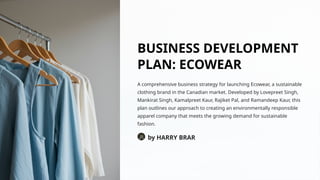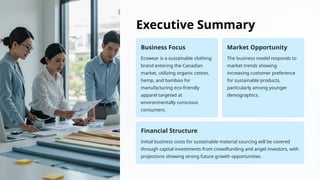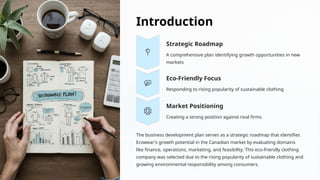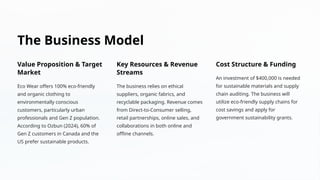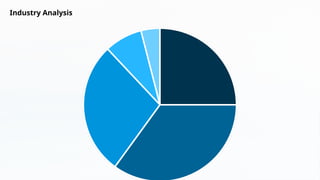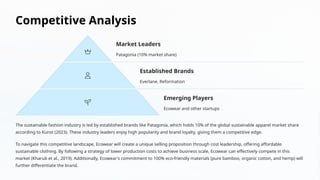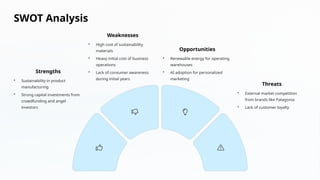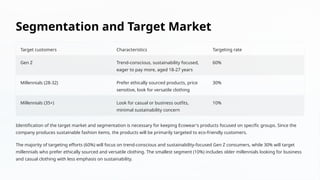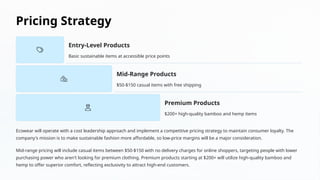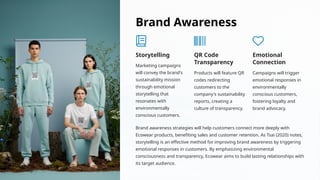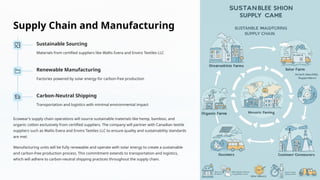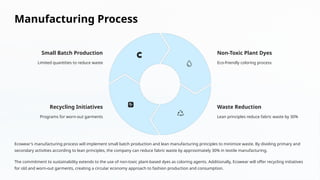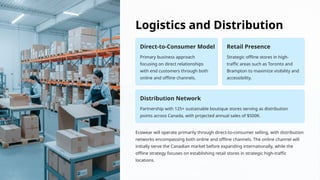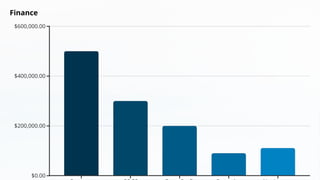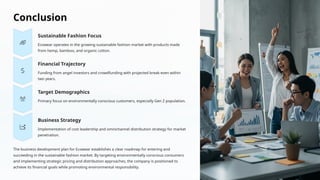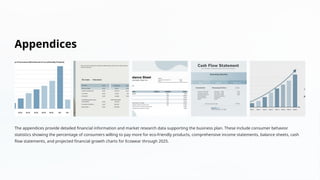BUSINESS-DEVELOPMENT-PLAN-ECOWEAR-4.pptx
- 1. BUSINESS DEVELOPMENT PLAN: ECOWEAR A comprehensive business strategy for launching Ecowear, a sustainable clothing brand in the Canadian market. Developed by Lovepreet Singh, Mankirat Singh, Kamalpreet Kaur, Rajiket Pal, and Ramandeep Kaur, this plan outlines our approach to creating an environmentally responsible apparel company that meets the growing demand for sustainable fashion. by HARRY BRAR
- 2. Executive Summary Business Focus Ecowear is a sustainable clothing brand entering the Canadian market, utilizing organic cotton, hemp, and bamboo for manufacturing eco-friendly apparel targeted at environmentally conscious consumers. Market Opportunity The business model responds to market trends showing increasing customer preference for sustainable products, particularly among younger demographics. Financial Structure Initial business costs for sustainable material sourcing will be covered through capital investments from crowdfunding and angel investors, with projections showing strong future growth opportunities.
- 3. Introduction Strategic Roadmap A comprehensive plan identifying growth opportunities in new markets Eco-Friendly Focus Responding to rising popularity of sustainable clothing Market Positioning Creating a strong position against rival firms The business development plan serves as a strategic roadmap that identifies Ecowear's growth potential in the Canadian market by evaluating domains like finance, operations, marketing, and feasibility. This eco-friendly clothing company was selected due to the rising popularity of sustainable clothing and growing environmental responsibility among consumers.
- 4. The Business Model Value Proposition & Target Market Eco Wear offers 100% eco-friendly and organic clothing to environmentally conscious customers, particularly urban professionals and Gen Z population. According to Ozbun (2024), 60% of Gen Z customers in Canada and the US prefer sustainable products. Key Resources & Revenue Streams The business relies on ethical suppliers, organic fabrics, and recyclable packaging. Revenue comes from Direct-to-Consumer selling, retail partnerships, online sales, and collaborations in both online and offline channels. Cost Structure & Funding An investment of $400,000 is needed for sustainable materials and supply chain auditing. The business will utilize eco-friendly supply chains for cost savings and apply for government sustainability grants.
- 6. Competitive Analysis Market Leaders Patagonia (10% market share) Established Brands Everlane, Reformation Emerging Players Ecowear and other startups The sustainable fashion industry is led by established brands like Patagonia, which holds 10% of the global sustainable apparel market share according to Kunst (2023). These industry leaders enjoy high popularity and brand loyalty, giving them a competitive edge. To navigate this competitive landscape, Ecowear will create a unique selling proposition through cost leadership, offering affordable sustainable clothing. By following a strategy of lower production costs to achieve business scale, Ecowear can effectively compete in this market (Kharub et al., 2019). Additionally, Ecowear's commitment to 100% eco-friendly materials (pure bamboo, organic cotton, and hemp) will further differentiate the brand.
- 7. Legal and Regulatory Considerations Minimum Wage Compliance The Canadian government has regulated the minimum wage at $17.75 per hour at federally regulated workplaces (Campbell, 2024). Textile Labelling Act Prohibits sellers from inaccurately labeling their products to make false claims (Government of Canada, 2022). Environmental Regulations Sustainable clothing firms must adhere to environmental regulations framed by the government. Product Labelling All textile materials must be properly labelled with relevant washing and caring information. For Ecowear to operate effectively in the Canadian market, the business must comply with these regulations. As the company plans to begin operations in Canada before expanding to new markets, adherence to local legal norms and government trade policies is essential for efficient business operation.
- 8. SWOT Analysis Strengths • Sustainability in product manufacturing • Strong capital investments from crowdfunding and angel investors Weaknesses • High cost of sustainability materials • Heavy initial cost of business operations • Lack of consumer awareness during initial years Opportunities • Renewable energy for operating warehouses • AI adoption for personalized marketing Threats • External market competition from brands like Patagonia • Lack of customer loyalty
- 9. Segmentation and Target Market Target customers Characteristics Targeting rate Gen Z Trend-conscious, sustainability focused, eager to pay more, aged 18-27 years 60% Millennials (28-32) Prefer ethically sourced products, price sensitive, look for versatile clothing 30% Millennials (35+) Look for casual or business outfits, minimal sustainability concern 10% Identification of the target market and segmentation is necessary for keeping Ecowear's products focused on specific groups. Since the company produces sustainable fashion items, the products will be primarily targeted to eco-friendly customers. The majority of targeting efforts (60%) will focus on trend-conscious and sustainability-focused Gen Z consumers, while 30% will target millennials who prefer ethically sourced and versatile clothing. The smallest segment (10%) includes older millennials looking for business and casual clothing with less emphasis on sustainability.
- 10. Pricing Strategy Entry-Level Products Basic sustainable items at accessible price points Mid-Range Products $50-$150 casual items with free shipping Premium Products $200+ high-quality bamboo and hemp items Ecowear will operate with a cost leadership approach and implement a competitive pricing strategy to maintain consumer loyalty. The company's mission is to make sustainable fashion more affordable, so low-price margins will be a major consideration. Mid-range pricing will include casual items between $50-$150 with no delivery charges for online shoppers, targeting people with lower purchasing power who aren't looking for premium clothing. Premium products starting at $200+ will utilize high-quality bamboo and hemp to offer superior comfort, reflecting exclusivity to attract high-end customers.
- 11. Marketing Channels 4.1M Active Social Media Users Current Canadian social media user base 12% Projected Growth Expected increase in Canadian social media users (2024-2029) 300K Instagram Goal Projected followers within two years 25% Email Marketing Target open rate for email campaigns Ecowear will utilize both online and offline marketing channels to introduce products and services to customers. With Canada's high internet penetration rate and growing social media usage, digital platforms will be a primary focus. The company will optimize digital marketing through influencer collaborations and partnerships with environmental awareness groups.
- 12. Brand Awareness Storytelling Marketing campaigns will convey the brand's sustainability mission through emotional storytelling that resonates with environmentally conscious customers. QR Code Transparency Products will feature QR codes redirecting customers to the company's sustainability reports, creating a culture of transparency. Emotional Connection Campaigns will trigger emotional responses in environmentally conscious customers, fostering loyalty and brand advocacy. Brand awareness strategies will help customers connect more deeply with Ecowear products, benefiting sales and customer retention. As Tsai (2020) notes, storytelling is an effective method for improving brand awareness by triggering emotional responses in customers. By emphasizing environmental consciousness and transparency, Ecowear aims to build lasting relationships with its target audience.
- 13. Supply Chain and Manufacturing Sustainable Sourcing Materials from certified suppliers like Wallis Evera and Enviro Textiles LLC Renewable Manufacturing Factories powered by solar energy for carbon-free production Carbon-Neutral Shipping Transportation and logistics with minimal environmental impact Ecowear's supply chain operations will source sustainable materials like hemp, bamboo, and organic cotton exclusively from certified suppliers. The company will partner with Canadian textile suppliers such as Wallis Evera and Enviro Textiles LLC to ensure quality and sustainability standards are met. Manufacturing units will be fully renewable and operate with solar energy to create a sustainable and carbon-free production process. This commitment extends to transportation and logistics, which will adhere to carbon-neutral shipping practices throughout the supply chain.
- 14. Manufacturing Process Small Batch Production Limited quantities to reduce waste Non-Toxic Plant Dyes Eco-friendly coloring process Waste Reduction Lean principles reduce fabric waste by 30% Recycling Initiatives Programs for worn-out garments Ecowear's manufacturing process will implement small batch production and lean manufacturing principles to minimize waste. By dividing primary and secondary activities according to lean principles, the company can reduce fabric waste by approximately 30% in textile manufacturing. The commitment to sustainability extends to the use of non-toxic plant-based dyes as coloring agents. Additionally, Ecowear will offer recycling initiatives for old and worn-out garments, creating a circular economy approach to fashion production and consumption.
- 15. Logistics and Distribution Direct-to-Consumer Model Primary business approach focusing on direct relationships with end customers through both online and offline channels. Retail Presence Strategic offline stores in high- traffic areas such as Toronto and Brampton to maximize visibility and accessibility. Distribution Network Partnership with 125+ sustainable boutique stores serving as distribution points across Canada, with projected annual sales of $500K. Ecowear will operate primarily through direct-to-consumer selling, with distribution networks encompassing both online and offline channels. The online channel will initially serve the Canadian market before expanding internationally, while the offline strategy focuses on establishing retail stores in strategic high-traffic locations.
- 16. Finance
- 17. Conclusion Sustainable Fashion Focus Ecowear operates in the growing sustainable fashion market with products made from hemp, bamboo, and organic cotton. Financial Trajectory Funding from angel investors and crowdfunding with projected break-even within two years. Target Demographics Primary focus on environmentally conscious customers, especially Gen Z population. Business Strategy Implementation of cost leadership and omnichannel distribution strategy for market penetration. The business development plan for Ecowear establishes a clear roadmap for entering and succeeding in the sustainable fashion market. By targeting environmentally conscious consumers and implementing strategic pricing and distribution approaches, the company is positioned to achieve its financial goals while promoting environmental responsibility.
- 18. Appendices The appendices provide detailed financial information and market research data supporting the business plan. These include consumer behavior statistics showing the percentage of consumers willing to pay more for eco-friendly products, comprehensive income statements, balance sheets, cash flow statements, and projected financial growth charts for Ecowear through 2025.
